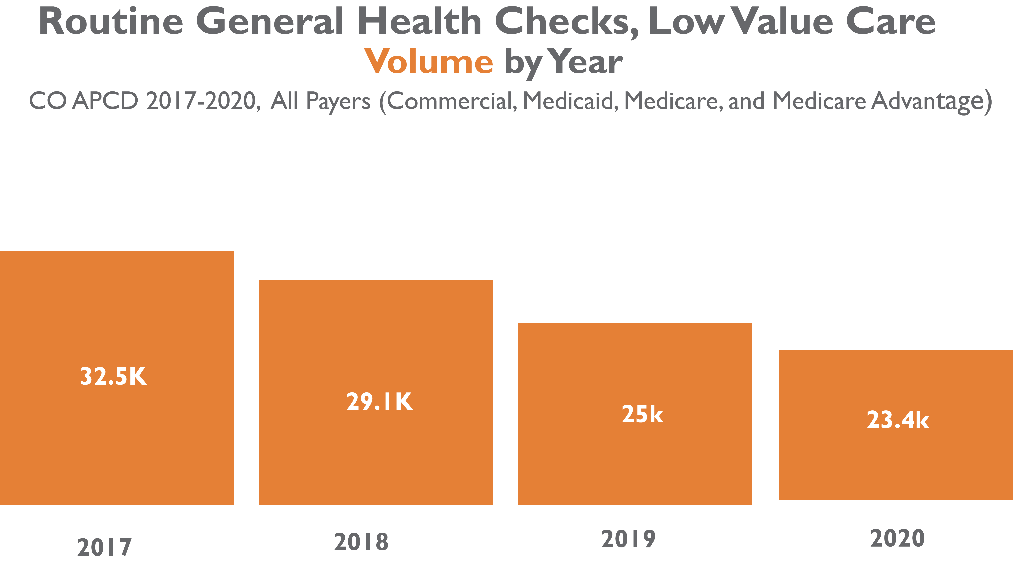CIVHC’s Affordability Dashboard has an updated Low Value Care analysis which identifies health care services that are often costly, do not improve health, and can in some instances cause harm.
The analysis, which evaluated 48 potentially low value services — including certain treatments, diagnostic tests, and screenings — found that in 2020, over $134 million was spent on low value care.
Across all health insurance payers, the top three services by spending were use of peripheral catheters in late state kidney disease patients, use of two or more antipsychotic medications, and use of opioids for acute back pain without trial of alternative medications, all of which have medium to high risk of harm to patients. To find the full list of the 48 services evaluated, see the Low Value Care Methodology.

To identify low value services, CIVHC teamed up with health care consulting firm Milliman to apply their MedInsight Health Waste Calculator to Colorado All Payer Claims Database (CO ACPD) data. The Choosing Wisely guidelines created by the American Board of Internal Medicine Foundation were used as a basis to determine low value care. It is important to note that there are more than 48 low value care services in the Choosing Wisely guidelines, but not all can be measured using claims data.
The Milliman tool evaluated potentially low value care services and classified them into the following categories:
- Necessary means clinically appropriate.
- Likely wasteful indicates the appropriateness of the services is questionable.
- Wasteful means the services were very likely unnecessary.
In the results, services that fell into the either likely wasteful or wasteful categories were considered low value care. Because claims data were used for the analysis, it is important to note that not all low value care services identified in this analysis should or can be eliminated. For example, a patient may have a family history or some other factors warranting a low value service that are not available in their claims information. It’s important that patients and providers discuss treatment options and consider all potential risks and benefits before making health care decisions.
Why are Routine General Health Checks Considered Low Value Care?
For patients with commercial insurance, the third most expensive low value care service in terms of annual cost is the routine general health check. This may be particularly surprising to consumers and some providers, and somewhat controversial since annual wellness visits are considered an important part of staying healthy and preventing disease and other health issues.
The Choosing Wisely guidelines define “health checkups” as potentially low value because annual physicals performed on healthy adults without a specific diagnostic reason generally do not improve a person’s health. Additionally, annual health checkups can result in tests or procedures “whose necessity should be questioned or discussed with a patient’s provider.”
During a general wellness check, doctors may order various tests, such as blood tests or an electrocardiogram (EKG), which are unnecessary for a healthy person without risk factors. These tests can bring unnecessary costs and add additional costs if a follow-up test is recommended. Additionally, over-testing may cause harm and undue stress on patients.
Although scientific studies have reliably shown that general wellness checks do not improve general health, there may be other reasons for a provider to recommend an annual exam such as family history that does not show up on the claims information. In addition, some providers argue that annual exams with a primary care provider can help foster a stronger patient/provider relationship which can be helpful long term. For a more detailed breakdown of the considerations around this measure, see CIVHC’s Low Value Care Public Report released in March 2020.
How Much Low Value Spending Do General Health Checks Account For?
Routine general health checks remain one of the highest cost low value care services for commercial insurance payers. In 2020, routine general health checks cost a total of $2.7 million (an average of $195 per service) with 13,870 services performed deemed low value.

However, spending on routine general health checks is declining. From 2017 to 2019, spending for the low value care category dropped gradually across payers, including dropping from $4.8 million to $4.1 million for commercial payers. Commercial payers experienced a sudden steep decline in spending on low value care in 2020, which is likely a result of the sharp decline in services due to the COVID-19 pandemic.

What Can You Do?
The Choosing Wisely guidelines provide several recommendations for patients to consider when determining if they need a health check or an annual exam.
Broadly, the guidelines recommend a patient see their doctor for identified services and concerns such as if they are sick, managing a chronic condition, or managing risk factors. Additionally, patients should see their doctor for specific types of care including a recommended test (such as a pap smear), prenatal care, or lifestyle needs such as family planning or STI prevention.
Awareness of what is low value care empowers individuals to make a direct, significant difference in their health care costs. Patients that know what could potentially be a low value service can by ask their doctor about the necessity of a procedure or a lab and avoid services that are unhelpful or potentially harmful. Visit the Affordability Dashboard to learn more about the top low value care services in Colorado.
Additional Resources:
